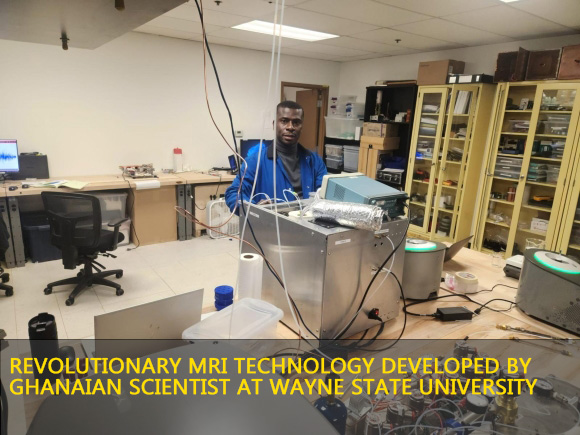A Ghanaian scientist, Joseph Nana Gyesi, and his research team at Wayne State University (USA) have unveiled a breakthrough in Magnetic Resonance Imaging (MRI) technology that could make advanced medical imaging far more accessible to hospitals across Africa.
The innovation, known as the Continuous Delivery of Cryogen-Free Xenon System, allows scientists to produce and maintain hyperpolarised xenon-129 gas without the need for expensive liquid nitrogen cooling systems. This advancement promises to revolutionize lung imaging and other diagnostic applications in low-resource environments.
How the New MRI Technology Works
Hyperpolarised xenon-129 gas is a specialized substance that can enhance MRI signals by over 10,000 times, giving doctors an unprecedented ability to observe organs — especially the lungs — in real time.
Traditionally, creating this gas required cryogenic systems cooled by liquid nitrogen, making it too costly and complex for hospitals in developing countries.
However, Mr. Gyesi’s cryogen-free system changes that by using room-temperature processes to polarize and continuously deliver xenon gas. This means hospitals no longer need cryogenic infrastructure, making the technology far more practical and affordable.
“We wanted to make powerful imaging technology more accessible, especially to parts of the world where cost and infrastructure often stand in the way,”
— Joseph Nana Gyesi, Lead Researcher, Wayne State University.
The Science Behind the Breakthrough: From Lasers to Lungs
The new system builds on a technique called spin-exchange optical pumping, where laser-excited rubidium vapour transfers its energy to xenon atoms, aligning their spins and amplifying MRI signals.
Unlike traditional setups that depend on liquid nitrogen to freeze and preserve the gas, the cryogen-free continuous delivery system keeps xenon polarized for up to 15 minutes at room temperature.
“We have shown that it’s possible to continuously deliver hyperpolarised xenon gas at room temperature, which means hospitals without cryogenic infrastructure can now consider using this powerful imaging tool,” Mr. Gyesi explained.
This continuous-flow model not only reduces cost but also ensures steady availability of hyperpolarised gas for MRI and analytical instruments — a major step toward democratizing advanced medical imaging.
Environmental and Operational Advantages
The cryogen-free technology offers significant environmental and practical benefits:
-
Energy Efficiency: It consumes far less power compared to cryogenic systems.
-
No Cryogen Storage: Eliminates the need for liquid nitrogen, which is difficult to transport and store in tropical regions.
-
Compact and Portable: The system’s design allows it to be used in smaller hospitals and laboratories without major infrastructure upgrades.
Mr. Gyesi highlighted that the system maintained over 16% magnetization even after travelling several meters through tubing — well within the range needed for clinical and laboratory use.
Potential Impact on African Healthcare
The implications of this development for African healthcare are profound. Many hospitals in Ghana and across the continent already possess MRI machines, but the high cost of imported contrast agents limits their diagnostic capabilities.
This homegrown innovation could offer a cost-effective and sustainable alternative, expanding what existing MRI systems can do.
“Many hospitals in Ghana already have MRI machines, but the high cost of imported contrast agents often limits them. This system offers a cost-effective alternative that could expand what those machines can do,” said Mr. Gyesi.
The technology could be particularly transformative for lung disease diagnosis — enabling doctors to detect and monitor conditions like asthma, pulmonary fibrosis, and chronic obstructive pulmonary disease (COPD) more effectively.
Beyond Medicine: New Frontiers in Science and Industry
The applications of hyperpolarised xenon gas go beyond medical imaging. It can act as a molecular sensor for scientific studies, helping researchers detect:
-
How drugs interact with their targets in the human body.
-
How gases are absorbed in materials — crucial for environmental and energy research.
Mr. Gyesi noted that the system’s simplicity and portability make it ideal for universities and research centers in Ghana and beyond, helping advance pharmaceutical, environmental, and energy-sector studies.
“It’s about making high-tech science possible in low-resource settings. This could change how we diagnose and study lung diseases — and even how we monitor drug interactions or material absorption in laboratories,” he emphasized.
A Step Toward Equitable Science and Technology
The Continuous Cryogen-Free Xenon System represents more than just a technical breakthrough — it’s a stride toward scientific equity.
By eliminating one of the biggest financial and logistical barriers to advanced imaging, Mr. Gyesi’s innovation aligns with global efforts to make cutting-edge medical technologies accessible to every region, regardless of infrastructure or income level.
This achievement not only showcases African scientific excellence but also reaffirms the continent’s potential to contribute transformative solutions to global healthcare challenges.



https://t.me/s/ef_beef